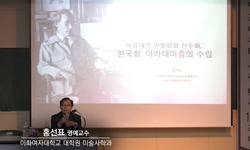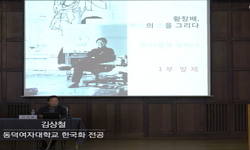이 글은 『21세기 찬송가』에 나타난 ‘한국화’된 곡을 음악적으로 분석하여 ‘한국화’된 양상을 고찰한 내용을 담고 있다. 그동안에 음악적 분석으로 연구된 한국교회음악에 대한 ‘한...
http://chineseinput.net/에서 pinyin(병음)방식으로 중국어를 변환할 수 있습니다.
변환된 중국어를 복사하여 사용하시면 됩니다.
- 中文 을 입력하시려면 zhongwen을 입력하시고 space를누르시면됩니다.
- 北京 을 입력하시려면 beijing을 입력하시고 space를 누르시면 됩니다.

『21세기 찬송가』의 "한국화" 연구 = A Study of Koreanized Christian Church Music in Korean Church -Focused on Hymns from 21th Century Hymnal
한글로보기https://www.riss.kr/link?id=A99954196
- 저자
- 발행기관
- 학술지명
- 권호사항
-
발행연도
2014
-
작성언어
-
- 주제어
-
KDC
230
-
등재정보
KCI등재후보
-
자료형태
학술저널
-
수록면
135-159(25쪽)
- 제공처
-
0
상세조회 -
0
다운로드
부가정보
국문 초록 (Abstract)
이 글은 『21세기 찬송가』에 나타난 ‘한국화’된 곡을 음악적으로 분석하여 ‘한국화’된 양상을 고찰한 내용을 담고 있다. 그동안에 음악적 분석으로 연구된 한국교회음악에 대한 ‘한국화’ 양상은 주로 한국전통음악의 음악적인 요소의 반영에 초점을 맞추었다. 하지만 이 글에서는 교회음악에 이루어진 ‘한국화’를 한국전통음악의 요소가 반영된 여부에만 초점 맞추지 않는다. 한국교회음악의 ‘한국화’는 현시대에 진정한 ‘한국화’를 인식하는 것이 요구되기 때문이다. 따라서 먼저 현시대의 진정한 ‘한국화’의 의미가 무엇인지를 진단하는 것이 선행되며 현재적 진단 뒤에 도출되는 의미에 따라 한국교회음악의 ‘한국화’를 살피는 것이 필요하다. 한국교회음악의 ‘한국화’된 양상을 살피기 위해 연구대상으로 삼은 것은 교회음악의 핵심인 찬송가이다. 연구대상으로 삼기에 적합한 찬송가는 현행찬송가인 『21세기 찬송가』이다. 『21세기 찬송가』에는 ‘한국화’된 곡이 풍부하기 때문이다. 『21세기 찬송가』의 ‘한국화’에 대한 연구는 먼저 ‘한국화’된 곡을 추려낸 다음에 작곡가별로 음악적으로 분석하여 ‘한국화’된 양상을 살펴보고자 한다. 작곡가별 분석이 끝난 뒤에는 ‘한국화’ 지수를 매겨 ‘한국화’된 양상을 가시화하였다. 도출된 ‘한국화’ 지수는 한국교회음악의 ‘한국화’에 대한 현재적 상황을 진단하고 현재적 상황에 맞는 한국화를 모색할 수 있는데 도움을 줄 것이다.
다국어 초록 (Multilingual Abstract)
This thesis analyzes the Koreanized Christian church hymns selected from 21th Century Hymnal. It sequentially suggests some practical methods and musical technics for the future development of authentic Koreanized church music in its context. The prev...
This thesis analyzes the Koreanized Christian church hymns selected from 21th Century Hymnal. It sequentially suggests some practical methods and musical technics for the future development of authentic Koreanized church music in its context. The previous studies on the Koreanized church music were done only in the perspectives of the past Korean traditional elements. This study, however, develops beyond those traditional components because the true Koreanized music must authentically reflect the current Korean musicality. Thus, it is necessary to correctly define what it means to be a Koreanized church music. This definition will subsequently aid to draw some practical suggestions on how to enhance the Koreanization of church music in the days to come. In order to achieve the objectives of this study, the following procedures were conducted: Firstly, as samples, several hymn songs with the prominently Koreanized components were selected from 21th Century Hymnal, which is used in the most churches in South Korea today. As the second step, the musical analyses were carried out according to the composers and their musical patterns and distinctiveness. Thirdly, based on the how Koreanized those songs were, they were systematically categorized with the scale of indexing figures. This study provides the accurate diagnoses and evaluations of the current Koreanization of Christian church songs as well as practical recommendations on development of the future directions.
동일학술지(권/호) 다른 논문
-
- 한국기독교철학회
- 이재영
- 2014
- KCI등재후보
-
- 한국기독교철학회
- 장성진
- 2014
- KCI등재후보
-
- 한국기독교철학회
- 이경재
- 2014
- KCI등재후보
-
- 한국기독교철학회
- 주시영
- 2014
- KCI등재후보




 KISS
KISS





